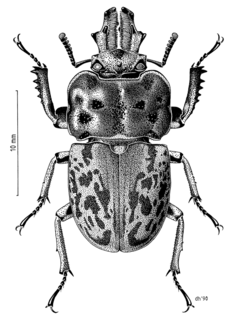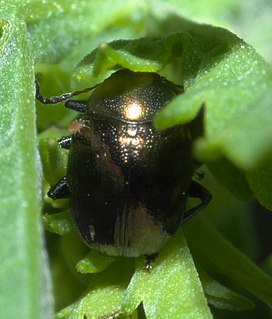Related Research Articles

Stag beetles are a family of about 1,200 species of beetles in the family Lucanidae, currently classified in four subfamilies. Some species grow to over 12 centimetres, but most to about 5 cm (2 in).
The false stag beetles (Diphyllostoma) are a group of three species of rare beetles known only from California. Almost nothing is known of their life history beyond that the adults are diurnal and females are flightless; larvae have not been observed.

Scarabaeoidea is a superfamily of beetles, the only subgroup of the infraorder Scarabaeiformia. Around 35,000 species are placed in this superfamily and some 200 new species are described each year. Its constituent families are also undergoing revision presently, and the family list below is only preliminary.

Potamotrygon is a genus of freshwater stingrays in the family Potamotrygonidae native to the rivers of South America, and sometimes seen in the aquarium trade.

Lucanus cervus, the European stag beetle, is one of the best-known species of stag beetle in Western Europe, and is the eponymous example of the genus. L. cervus is listed as Near Threatened by the IUCN Red List.

Ryssonotus nebulosus is a beetle of the family Lucanidae, and the sole member of the genus Ryssonotus. It is found in Queensland and New South Wales, Australia.

The minute tree-fungus beetles, family Ciidae, are a sizeable group of beetles which inhabit Polyporales bracket fungi or coarse woody debris. Most numerous in warmer regions, they are nonetheless widespread and a considerable number of species occur as far polewards as Scandinavia for example.
The Lucanidae are a family of beetles that include the stag beetles. The family can be further subdivided in a taxonomy. The classification presented here follows Smith (2006), with the exception of the tribal classification within the Lucaninae.

Chiasognathus grantii is a species of stag beetle found in Argentina and Chile. It is known as Darwin's beetle, Grant's stag beetle, or the Chilean stag beetle.

The golden stag beetle is a species of beetles in the family Lucanidae. It measures between 15 and 25 mm in length and is relatively common throughout Australia, and fairly variable in coloration, so has been given many names by various authors. In Tasmania, this species is referred to by the "common name" of Christmas beetle, a name that is normally used for beetles in the family Scarabaeidae, genus Anoplognathus. Females are smaller than the males, and males have the mandibles enlarged and prolonged forwards. The colour of the males is typically metallic golden green or golden yellow, while females may be blue, blue-green or also dull brown. These beetles are sapro-xylophagous, feeding only on dead wood, mainly Eucalyptus species (Myrtaceae) or Acacia.

Paralissotes reticulatus, also called the New Zealand reticulate stag beetle, is a native species of stag beetle from New Zealand. Although they do have wings they are flightless.

Pristionchus is a genus of nematodes (roundworms) in the family Diplogastridae that currently includes more than 50 described species. They are known mainly as non-parasitic associates of insects, especially beetles, while others have been reported from soil, organic matter, or rotting wood. The genus includes P. pacificus, a satellite model organism to the well-studied nematode Caenorhabditis elegans.

The Spilopyrinae are a small subfamily of the leaf beetles, or Chrysomelidae. They occur in Australia, New Guinea, New Caledonia and Chile. They were formerly considered a tribe of the subfamily Eumolpinae. The group was elevated to subfamily rank by C. A. M. Reid in 2000. However, some authors have criticised this placement, preferring to retain them within the Eumolpinae.

Calligrapha is a genus of large American Chrysomelinae of imprecise taxonomic boundaries. Most species occur in Central and South America.

Apterocyclus is a genus of rare stag beetles in the family Lucanidae. There are about five described species in Apterocyclus. The species of Apterocyclus are found only on the island of Kauai in the Hawaiian Islands, and are the only scarabaeoid beetles native to the Hawaiian Islands.

Eumolpini is a tribe of leaf beetles in the subfamily Eumolpinae. It is the largest tribe in the subfamily, with approximately 170 genera found worldwide. Members of the tribe almost always have a longitudinal median groove on the pygidium, which possibly helps to keep the elytra locked at rest. They also generally have a subglabrous body, as well as appendiculate pretarsal claws.

Cyclaxyridae are a family of beetles in the superfamily Cucujoidea. The only living genus is Cyclaxyra, with two species endemic to New Zealand. Other species have been named from fossils. They are also known as sooty mould beetles due to the association of Cyclaxyra with sooty mould. The extant species are mycophagous, feeding on spores, conidia, and hyphae.

Paralissotes is a genus of stag beetle that are endemic to New Zealand.

Epimetopidae is a family of semi-aquatic beetles found on the edges of streams and shallow freshwater ponds. These beetles are shorter than half a centimeter long and have a pronotum with a central projection forming a shelf above the head. On the underside of the abdomen only four sternites are visible. There are less than a hundred species in three genera, Epimetopus which is restricted to the New World, mostly Neotropical, Eupotemus with two Afrotropical species and Eumetopus with some Oriental species. Females carry their eggcases on the underside of the abdomen.
References
- ↑ Reid, C.A.M.; Beatson, M. 2016: Revision of the stag beetle genus Ryssonotus MacLeay (Coleoptera: Lucanidae), with descriptions of a new genus and three new species. Zootaxa, 4150(1): 1-39. doi : 10.11646/zootaxa.4150.1.1